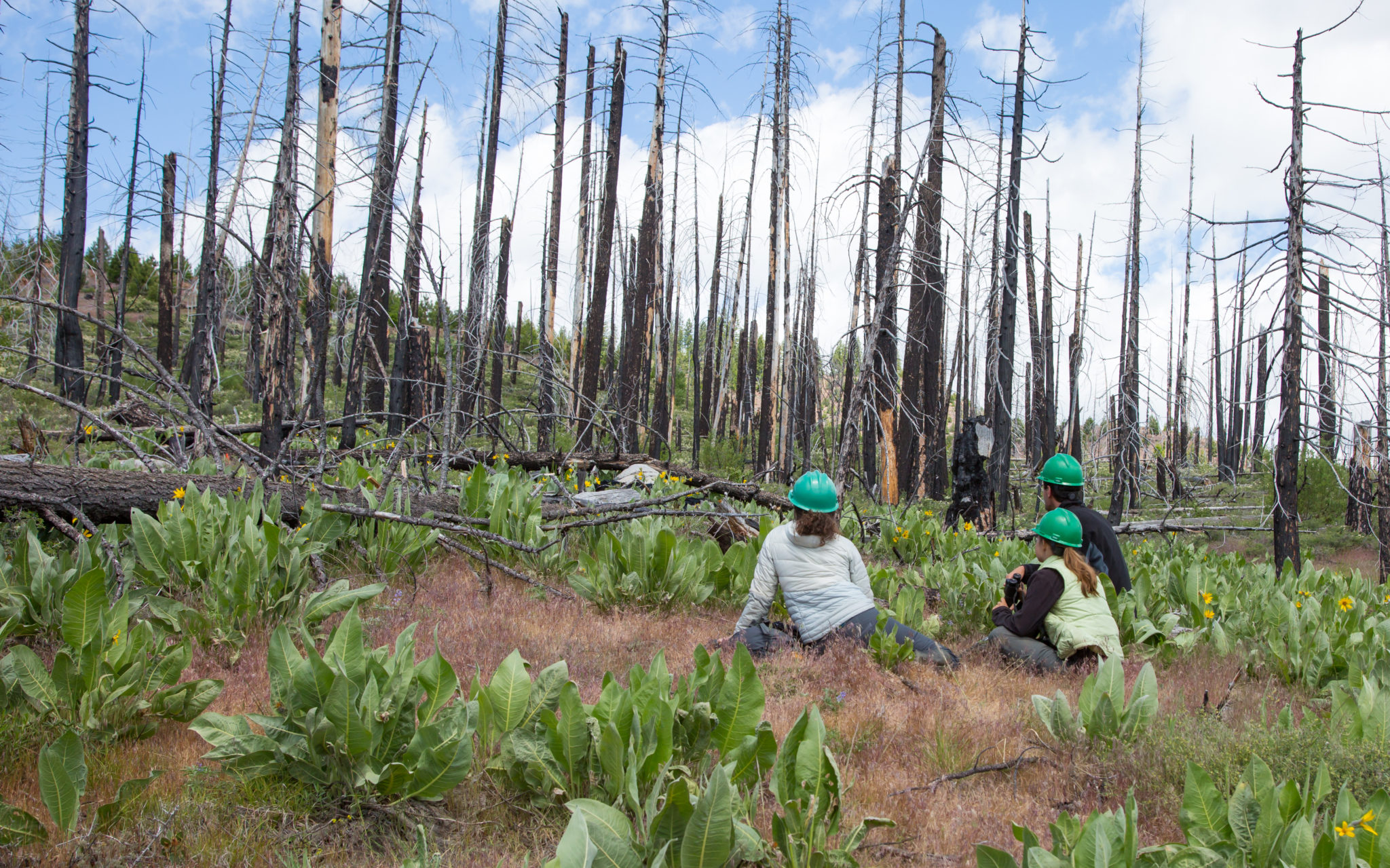Guest post by researcher Andrew Stillman
Linked paper: Nest site selection and nest survival of Black-backed Woodpeckers after wildfire by A.N. Stillman, R.B. Siegel, R.L. Wilkerson, M. Johnson, C.A. Howell, and M.W. Tingley, The Condor: Ornithological Applications.
It’s fire season again in northern California. In some parts of the state, the evenings will glow with those too-familiar burnt orange sunsets while residents keep a wary eye on the news. Although wildfire can sometimes be catastrophic to human life and property, the raging flames don’t usually create lifeless wastelands. Walk through a recently burned forest, and you’ll be met with a myriad of birdsong. Fresh herbaceous growth and numerous wildflowers dot the forest floor, and woodboring beetles gnaw their way through burned trees. Then — if you’re lucky — you’ll hear it: the accelerating drum of the Black-backed Woodpecker.
Black-backed Woodpeckers are strongly associated with recently burned forests in the western U.S. They colonize these habitats rapidly after fire to take advantage of abundant post-fire resources, such as the dead trees that provide nest sites and access to a feast of woodboring beetle larvae. These birds may be jeopardized by logging activities that can destroy or degrade post-fire habitat, and Black-backed Woodpeckers are sometimes used as an indicator species to guide management activities on the post-fire landscape.
But post-fire landscapes are changing. Many recent studies indicate that current environmental conditions are yielding larger, more severe wildfires that leave post-fire habitat conditions outside of the historical norm. Add that to threats from post-fire logging, and we urgently need to understand how habitat specialists like the Black-backed Woodpecker will respond to these new conditions.

My colleagues from The Institute for Bird Populations and the U.S. Forest Service and I examined how Black-backed Woodpeckers use burned forest when deciding where to breed and whether the factors that influence nesting habitat selection also influence nest success. Over the course of eight years, we located 118 Black-backed Woodpecker nests in areas burned by six different fires, carefully monitoring the fate of each and surveying the characteristics of the surrounding habitat. Black-backed Woodpeckers selected moderately-sized nest trees in areas of high dead tree density burned at high severity. They also tended to select nest sites towards the outer edges of high burn severity patches. While our results showed strong relationships between nest site selection and habitat characteristics, we were surprised to find that none of the habitat variables that we measured affected nest success. Only nest initiation date had a strong effect, with early-season nests typically showing more success than late-season nests.
We already knew that Black-backed Woodpeckers select nesting habitat with high densities of dead trees, but our results reveal an important nuance to this association with severely-burned forest. The birds in our study selected nest sites near the edges of severely burned patches — “ecotones” where the habitat transitions from severely-burned dead trees to intact living trees. The term for this is “pyrodiversity,” referring to the amount of variation in fire severity within an area and the different post-fire habitats that result. It seems that pyrodiversity is important for breeding Black-backed Woodpeckers. A related study, published recently in the Journal of Applied Ecology, found a similar positive association between pyrodiversity and the woodpeckers’ foraging habitat.
Changing fire regimes in the American West are leaving larger, more uniform areas of severely burned forest. This means less variation in post-fire landscapes, and potentially less habitat for pyrodiversity-loving species like the Black-backed Woodpecker. Our research suggests that land managers can manage burned forests to benefit Black-backed Woodpeckers by prioritizing retention of burned stands with dense dead trees located adjacent to areas burned at low severity or left unburned.

Test comment.
Could you provide some citations for this statement: “Many recent studies indicate that current environmental conditions are yielding larger, more severe wildfires that leave post-fire habitat conditions outside of the historical norm. ” I’d love to read some of those.
“Changing fire regimes in the American West are leaving larger, more uniform areas of severely burned forest. ” I see this kind of assertion made regularly in popular media, but when I go look at burn severity data for large wildfires here in northwestern California, it seems to show the kind of pyrodiversity that leads to a mosaic landscape, favoring biodiversity. Perhaps the statement refers to fires in other types of forest or geographic regions.
https://www.fs.fed.us/psw/publications/skinner/psw_2012_skinner001.pdf did not detect a trend in fire severity, despite clear trends (increasing) in frequency and burned area.